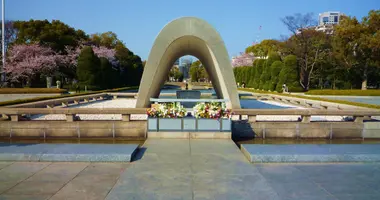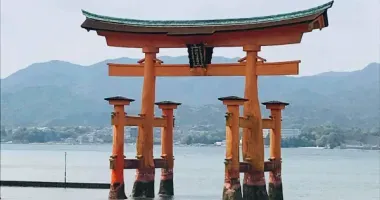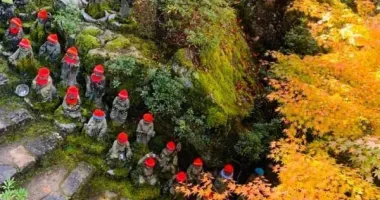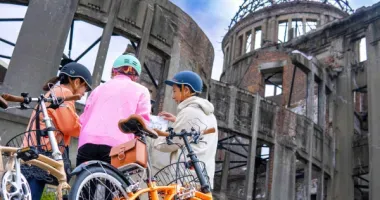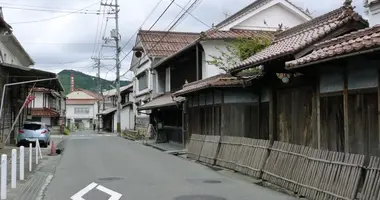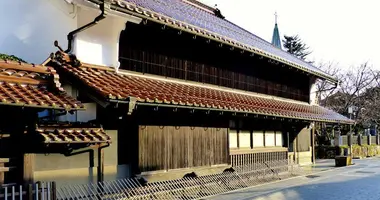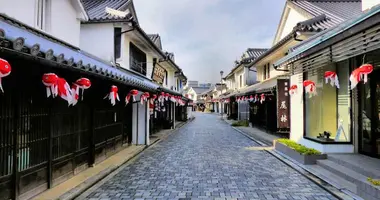Omishima Guide
Omishima guide: read a guide to Omishima in the Inland Sea and its many museums including the Tokoro Art Museum, the Toyo Ito Museum of Architecture and the Ken Iwata Mother and Child Museum.
Omishima Art and Architecture 大三島
- Ikuchijima Museums
- Omishima Art Museum
- Murakami Santo Memorial Hall
- Tokoro Art Museum
- Toyo Ito Museum of Architecture
- Ken Iwata Mother & Child Museum
- Access - Getting to Omishima
Jake Davies
July, 2016
The islands of the Seto Inland Sea between Shikoku and Honshu have become world famous as a destination for art lovers, primarily through the island of Naoshima, where the Benesse Corporation have built numerous world-class museums and other art-sites and installations.
From Naoshima Benesse expanded their art sites to several neighbouring islands, and since 2010 the Setouchi Triennale Arts Festival takes place on a full dozen of the islands and also Takamatsu on Shikoku.
However, at the western end of the Inland Sea, the group of islands that comprise the Shimanami Kaido, is home to a variety of art museums and installations, that while maybe not as well known as those around Naoshima, are also not as crowded nor as expensive.
 Omishima Museum of Art, Omishima
Omishima Museum of Art, Omishima Tokoro Art Museum
Tokoro Art Museum
Ikuchijima Museums
Ikuchijima, for instance, is home to the Hirayama Ikuo Art Museum devoted to the works of the major Nihonga painter, the Island Wide Art Museum, consisting of 17 large scale sculptures dotted around the island, Miraishin no Oka, a hilltop covered in 5,000 square meters of gleaming Carrara marble topped with sculptures made of the same marble by sculptor Kazuto Kuetani, and the Kosan-ji Museum housing a major collection of Buddhist art as well as tea ceremony utensils.
Omishima Art Museum
The neighboring island of Omishima has even more art establishments. Most visitors to Omishima will be heading for the Oyamazumi Shrine, whose museum has the greatest collection of historical samurai weaponry and armour in the whole of Japan. Just opposite the entrance to the shrine is a rather distinctive A-frame structure, the Omishima Art Museum.
Opened in 1986, the Omishima Art Museum shows a wide range of contemporary Nihonga, Japanese style paintings, of which the museum has already built up a collection of over 1,000 pieces including works by Yukio Umehara, Hatanaka Hikaritoru, Masaru Matsumoto, Shigeki Murata and Chinami Nakajima.
Large scale works by Toshio Tabuchi are on permanent display, but the three other galleries have continuously changing temporary exhibitions, often on seasonal themes. For a provincial museum, the exhibits are of quite a high quality and diversity.
Omishima Museum of Art
9099-1 Miyaura, Omishima-cho
Imabari, Ehime 794 1304
Tel: 0897 82 1234
Open from 9 am to 5 pm. Closed Mondays and over the new year.
Entry for adults is 500 yen, students 250 yen, under 18's free.
Murakami Santo Memorial Hall
Across on the other side of the island, near to where the bridges connect to the Shimanami Kaido, is a museum that might be worth visiting if you have a big interest in calligraphy (shodo).
Claiming to be the biggest museum of calligraphy in Japan, the Murakami Santo Memorial Hall displays calligraphy and calligraphy materials mostly from the noted calligrapher Murakami Santo who was born nearby. Probably not of much interest unless you are really into calligraphy.
Murakami Santo Memorial Hall
7505 Inokuchi, Kamiura-cho
Imabari-shi, Ehime 794-1402
Tel: 0897 87 4288
Open from 9 am to 5 pm. Closed Mondays and over the New Year.
Entry is 500 yen for adults.
 Tokoro Art Museum
Tokoro Art Museum
Tokoro Art Museum
The real gems of the Omishima art scene though, can be found in the remote southwest coast of the island where there is a cluster of three unusual museums.
The first one reached either by infrequent local bus, car, or bike if you are cycling the Shimanami Kaido, is also the first one built, in 2004, and you will be struck by its unusual architecture and location.
Situated high on a very steep slope with fantastic views over the surrounding islands is the Tokoro Art Museum. It's hard to imagine building on such a steep site, but the structure is very simple - two parallel concrete walls running down the slope topped by a curved wooden lattice supporting a translucent roof.
The interior steps down through several levels, and unusually access is via a covered, exterior corridor. The lowest level of the museum is an outdoor balcony where you can sit and drink coffee while also drinking in the fantastic views.
The art at the Tokoro Art Museum is contemporary and three dimensional, featuring artists such as Noe Katz, Marisol, Giacomo Manzu and Munehiro Ikeda. The works are from the collection of Atsuo Tokoro, and there is more than a dash of humor in the art on display.
Tokoro Museum of Art
2362-3 Urado, Omishima-cho
Imabari-shi, Ehime 794-1308
Tel: 0897 83 0380
Open from 9 am to 5 pm. Closed Mondays and over the New Year. Entry is 300 yen for adults.
 Steel Hut at Toyo Ito Museum of Architecture, Omishima
Steel Hut at Toyo Ito Museum of Architecture, Omishima Silver Hut at Toyo Ito Museum of Architecture, Omishima
Silver Hut at Toyo Ito Museum of Architecture, Omishima
Toyo Ito Museum of Architecture
Just a short distance away, and visible from the Tokoro Museum is the Toyo Ito Museum of Architecture. Toyo Ito, a Pritzker Prize winner, is an internationally acclaimed architect whose most famous work is probably the Sendai Mediatheque in Sendai, northern Japan, but is most famous for his conceptual works rather than actual buildings.
Tokoro began discussions with him about building an annex for the Tokoro Museum, but ended up supporting Ito's idea of a museum and workspace for young architects to be able to meet and work together, and so the Toyo Ito Museum of Architecture was born.
Consisting primarily of two buildings, both designed by Ito, the main building is the Steel Hut, a conglomeration of polyhedra in dark steel which makes for some very unusual internal spaces that display models and drawings of Ito's work and other exhibits.
The second building is the Silver Hut, a reconstruction of the home Ito built for himself in Tokyo in 1985 and the building that brought him to attention. The silver hut is light and airy and contains study areas and workshops for visiting students. Like the Tokoro Museum, there are fantastic views over the islands.
Toyo Ito Museum of Architecture
2418 Urado, Omishima-cho
Imabari-shi, Ehime 794-1308
Tel: 0897 74 7220
Open from 9 am to 5 pm. Closed Mondays and over the New Year holiday period. Entry 300 yen for adults.
 Ken Iwata Mother & Child Museum, Omishima
Ken Iwata Mother & Child Museum, Omishima
Ken Iwata Mother & Child Museum
Further down the coast road in the fishing village of Munakata is the Ito-designed Ken Iwata Mother & Child Museum. Located next to the beach in the grounds of a former elementary school.
This unusual museum is mostly outdoor. The circular concrete walls contain more than 40 statues by Ken Iwata, and as might be suspected by the name, they are mostly of children and mothers.
Walking around you get to see the statues against a variety of backgrounds: white concrete, blue sky, green grass etc. The statues are mostly bronze and traditional.
 Ken Iwata Mother & Child Museum, Omishima
Ken Iwata Mother & Child Museum, Omishima
Ken Iwata Mother & Child Museum
5208-2 Munakata, Omishima-cho
Imabari-shi, Ehime 794-1309
Tel: 0897 83 0383.
Open from 9 am to 5 pm. Closed Mondays and over the New Year. Entry 300 yen for adults.
Right next door to the museum the old, wooden elementary school has been converted into ryokan style accommodation. The prices, including meals, are reasonable.
Ikoi no Ie (ikoinoie.co.jp)
5208-1 Munakata, Omishima-cho, Imabari-shi, Ehime 794-1309
Tel: 0897 83 1111
 Ikoi no Ie, Omishima
Ikoi no Ie, Omishima
Access
Omishima is roughly half way between the main island of Honshu and the island of Shikoku. There are no train services to the island.
Buses run from either Imabari on Shikoku or Onomichi in Hiroshima. By hire car it is about 40 minutes from Imabari or 30 minutes from Onomichi. There are local buses around the island. A popular way to visit the island is by bicycle along the Shimanami Kaido Bike Route.
There are buses to Omishima Island from JR Matsuyama Station in Matsuyama in Shikoku.

